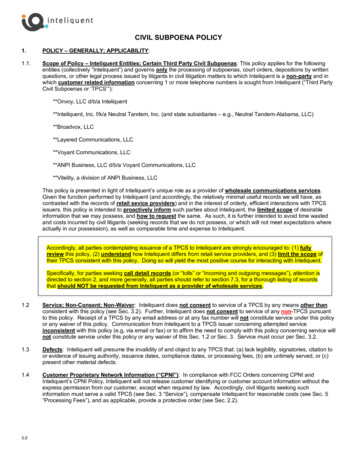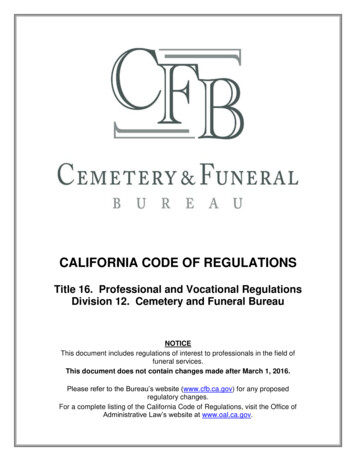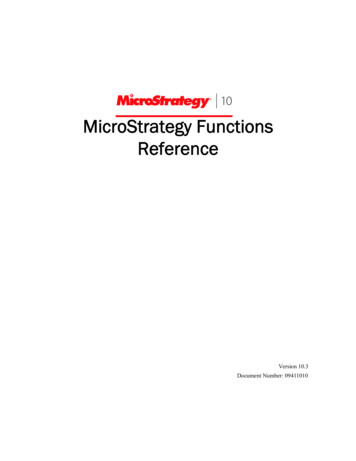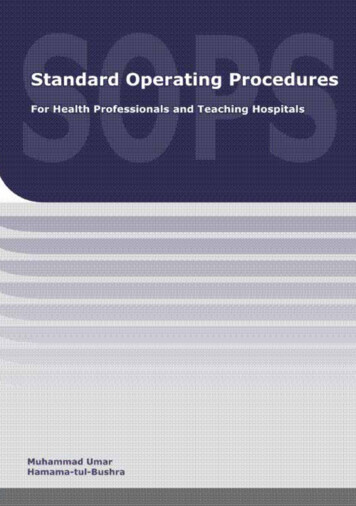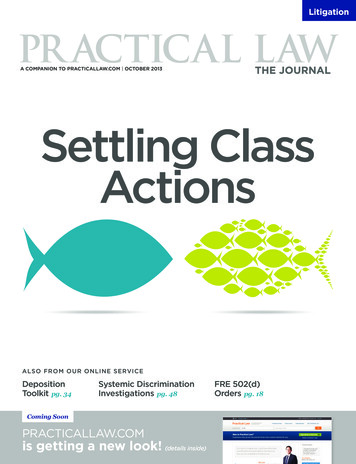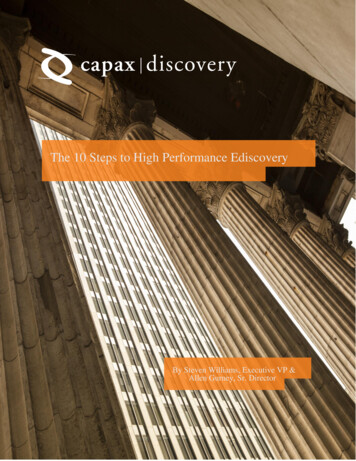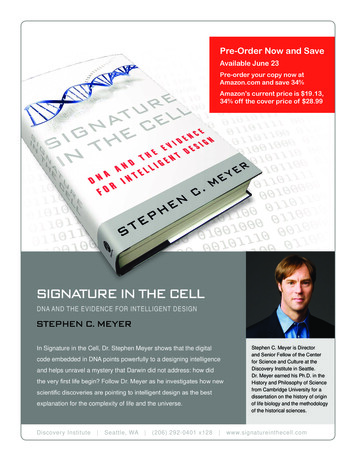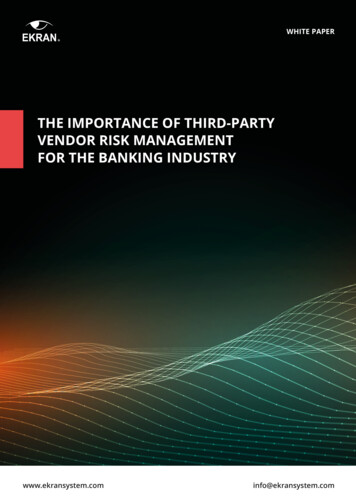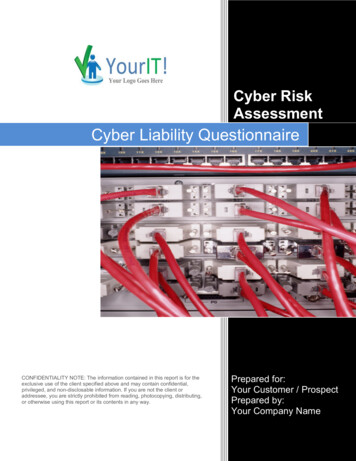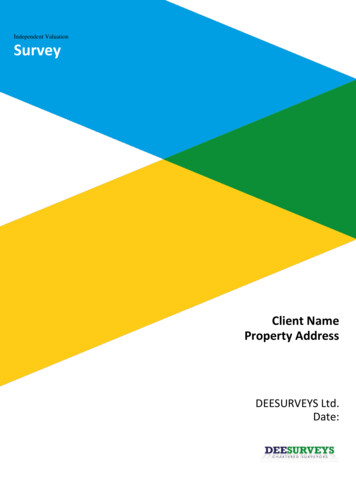
Transcription
Presenting a live 90-minute webinar with interactive Q&AFRCP 45 Third-Party Subpoenas:Using or Objecting to Subpoenasto Obtain Testimony and EvidenceTUESDAY, APRIL 11, 20171pm Eastern 12pm Central 11am Mountain 10am PacificToday’s faculty features:Darren A. Craig, Member, Frost Brown Todd, IndianapolisJonathan Evan Goldberg, Partner, FisherBroyles, New YorkThe audio portion of the conference may be accessed via the telephone or by using your computer'sspeakers. Please refer to the instructions emailed to registrants for additional information. If youhave any questions, please contact Customer Service at 1-800-926-7926 ext. 10.
Tips for Optimal QualityFOR LIVE EVENT ONLYSound QualityIf you are listening via your computer speakers, please note that the qualityof your sound will vary depending on the speed and quality of your internetconnection.If the sound quality is not satisfactory, you may listen via the phone: dial1-866-869-6667 and enter your PIN when prompted. Otherwise, pleasesend us a chat or e-mail sound@straffordpub.com immediately so we canaddress the problem.If you dialed in and have any difficulties during the call, press *0 for assistance.Viewing QualityTo maximize your screen, press the F11 key on your keyboard. To exit full screen,press the F11 key again.
Continuing Education CreditsFOR LIVE EVENT ONLYIn order for us to process your continuing education credit, you must confirm yourparticipation in this webinar by completing and submitting the AttendanceAffirmation/Evaluation after the webinar.A link to the Attendance Affirmation/Evaluation will be in the thank you emailthat you will receive immediately following the program.For additional information about continuing education, call us at 1-800-926-7926ext. 35.
Program MaterialsFOR LIVE EVENT ONLYIf you have not printed the conference materials for this program, pleasecomplete the following steps: Click on the symbol next to “Conference Materials” in the middle of the lefthand column on your screen. Click on the tab labeled “Handouts” that appears, and there you will see aPDF of the slides for today's program. Double click on the PDF and a separate page will open. Print the slides by clicking on the printer icon.
Rule 45 Third-PartySubpoenasUsing or Objecting to Subpoenas toObtain Testimony and EvidenceJonathan Evan Goldberg, Esq.
Speaker Bio: Jonathan Evan Goldberg, Esq.Jonathan Evan Goldberg is a litigation and employment law partner at FisherBroyles, LLP. An experienced trial lawyer and frequent public speaker, he hasrepresented corporations, LLCs, partnerships, non-profits, law firms, and boards ofdirectors, as well as officers, executives, attorneys, and others, in all aspects of complexcommercial litigation, employment litigation, arbitration, and employment law.T: 212.724.9090M: 917.570.7684jonathan.goldberg@fisherbroyles.comBar Admissions: NewYork, New Jersey,SDNY, EDNY, DNJ,2nd Circuit, 3rd CircuitDuring his 21-year legal career, Mr. Goldberg has litigated hundreds of cases in federaland state courts throughout the United States involving claims of retaliation,discrimination, wrongful termination, fraud, defamation, breach of fiduciary duty, andbreach of contract, as well as commercial contract disputes, civil RICO, ERISA, tradesecrets and restrictive covenants, corporate governance disputes, minority shareholderdisputes, partnership disputes, Madoff counseling and defense, advancement andindemnification proceedings, whistleblower actions (SOX and CEPA), executivecompensation counseling, litigation, and arbitration, international litigation andarbitration, antitrust litigation and arbitration, products liability litigation,environmental and toxic tort litigation, and securities fraud. Jonathan has alsodefended corporate and individual clients in connection with investigations by the USDepartment of Labor (DOL) and the US Department of Justice (DOJ), and isexperienced in bringing and defending against TROs (temporary restraining orders)and preliminary injunctions in federal and state courts. He has also handled a numberof state and federal appeals.Jonathan also concentrates on and advises US and multinational corporations andexecutives in all aspects of employment law, including drafting and negotiatingemployment and separation agreements, corporate restructurings and reductions inforce, employment advice related to corporate transactions, internal corporateinvestigations, handbooks and policy manuals, sexual harassment and other sensitivitytraining, protecting against employee raiding and theft of confidential information, andcompliance with all federal, state, and local discrimination laws.Jonathan is also a trained and skilled mediator and always explores ways to resolvedisputes early so that his clients can focus on their business and personal matters.6
Preparing and serving thirdparty subpoenas Required contents Issuing the subpoena Serving the subpoena Notice of subpoena7
Required Contents of SubpoenaRule 45. Subpoena(a) In General.(1) Form and Contents.(A) Requirements—In General. Every subpoena must:(i) state the court from which it issued;(ii) state the title of the action and its civil-action number;(iii) command each person to whom it is directed to do thefollowing at a specified time and place: attend and testify;produce designated documents, electronically storedinformation, or tangible things in that person's possession,custody, or control; or permit the inspection of premises;and (iv) set out the text of Rule 45(d) and (e). 8
Required Contents Cont. (B) Command to Attend a Deposition—Notice of the Recording Method. Asubpoena commanding attendance at a deposition must state the method forrecording the testimony. (C) Combining or Separating a Command to Produce or to Permit Inspection;Specifying the Form for Electronically Stored Information. A command toproduce documents, electronically stored information, or tangible things or topermit the inspection of premises may be included in a subpoena commandingattendance at a deposition, hearing, or trial, or may be set out in a separatesubpoena. A subpoena may specify the form or forms in which electronicallystored information is to be produced. (D) Command to Produce; Included Obligations. A command in a subpoena toproduce documents, electronically stored information, or tangible thingsrequires the responding person to permit inspection, copying, testing, orsampling of the materials.9
Issuance and Service (2) Issuing Court. A subpoena must issue from the court where the action ispending. (3) Issued by Whom. The clerk must issue a subpoena, signed but otherwise inblank, to a party who requests it. That party must complete it before service. Anattorney also may issue and sign a subpoena if the attorney is authorized topractice in the issuing court. (4) Notice to Other Parties Before Service. If the subpoena commands theproduction of documents, electronically stored information, or tangible thingsor the inspection of premises before trial, then before it is served on the personto whom it is directed, a notice and a copy of the subpoena must be served oneach party. (b) Service. (1) By Whom and How; Tendering Fees. Any person who is at least 18 years oldand not a party may serve a subpoena. Serving a subpoena requires delivering acopy to the named person and, if the subpoena requires that person'sattendance, tendering the fees for 1 day's attendance and the mileage allowedby law. Fees and mileage need not be tendered when the subpoena issues onbehalf of the United States or any of its officers or agencies.10
Service cont. and Place of Compliance (2) Service in the United States. A subpoena may be served at any place withinthe United States. (3) Service in a Foreign Country. 28 U.S.C. §1783 governs issuing and serving asubpoena directed to a United States national or resident who is in a foreigncountry. (4) Proof of Service. Proving service, when necessary, requires filing with theissuing court a statement showing the date and manner of service and thenames of the persons served. The statement must be certified by the server. (c) Place of Compliance. (1) For a Trial, Hearing, or Deposition. A subpoena may command a person toattend a trial, hearing, or deposition only as follows: (A) within 100 miles of where the person resides, is employed, or regularlytransacts business in person; or (B) within the state where the person resides, is employed, or regularlytransacts business in person, if the person (i) is a party or a party's officer; or (ii) is commanded to attend a trial and would not incur substantial expense.11
Other Discovery (2) For Other Discovery. A subpoena maycommand: (A) production of documents, electronically storedinformation, or tangible things at a place within 100miles of where the person resides, is employed, orregularly transacts business in person; and (B) inspection of premises at the premises to beinspected.12
Form Subpoena13
(d) Protecting a Person Subject toa Subpoena; Enforcement. (1) Avoiding Undue Burden or Expense; Sanctions. A party or attorney responsiblefor issuing and serving a subpoena must take reasonable steps to avoid imposingundue burden or expense on a person subject to the subpoena. The court for thedistrict where compliance is required must enforce this duty and impose anappropriate sanction—which may include lost earnings and reasonable attorney'sfees—on a party or attorney who fails to comply. (2) Command to Produce Materials or Permit Inspection. (A) Appearance Not Required. A person commanded to produce documents,electronically stored information, or tangible things, or to permit the inspection ofpremises, need not appear in person at the place of production or inspection unlessalso commanded to appear for a deposition, hearing, or trial. (B) Objections. A person commanded to produce documents or tangible things orto permit inspection may serve on the party or attorney designated in the subpoenaa written objection to inspecting, copying, testing or sampling any or all of thematerials or to inspecting the premises—or to producing electronically storedinformation in the form or forms requested. The objection must be served beforethe earlier of the time specified for compliance or 14 days after the subpoena isserved. If an objection is made, the following rules apply: (i) At any time, on notice to the commanded person, the serving party may movethe court for the district where compliance is required for an order compellingproduction or inspection. (ii) These acts may be required only as directed in the order, and the order mustprotect a person who is neither a party nor a party's officer from significantexpense resulting from compliance.14
(3) Quashing or Modifying aSubpoena. (A) When Required. On timely motion, the court for the district where compliance isrequired must quash or modify a subpoena that: (i) fails to allow a reasonable time to comply; (ii) requires a person to comply beyond the geographical limits specified in Rule 45(c); (iii) requires disclosure of privileged or other protected matter, if no exception or waiverapplies; or (iv) subjects a person to undue burden. (B) When Permitted. To protect a person subject to or affected by a subpoena, the courtfor the district where compliance is required may, on motion, quash or modify thesubpoena if it requires: (i) disclosing a trade secret or other confidential research, development, or commercialinformation; or (ii) disclosing an unretained expert's opinion or information that does not describespecific occurrences in dispute and results from the expert's study that was not requestedby a party. (C) Specifying Conditions as an Alternative. In the circumstances described in Rule45(d)(3)(B), the court may, instead of quashing or modifying a subpoena, orderappearance or production under specified conditions if the serving party: (i) shows a substantial need for the testimony or material that cannot be otherwise metwithout undue hardship; and (ii) ensures that the subpoenaed person will be reasonably compensated.15
(e) Duties in Responding to a Subpoena. (1) Producing Documents or Electronically Stored Information. Theseprocedures apply to producing documents or electronically storedinformation: (A) Documents. A person responding to a subpoena to produce documentsmust produce them as they are kept in the ordinary course of business or mustorganize and label them to correspond to the categories in the demand. (B) Form for Producing Electronically Stored Information Not Specified. If asubpoena does not specify a form for producing electronically storedinformation, the person responding must produce it in a form or forms inwhich it is ordinarily maintained or in a reasonably usable form or forms. (C) Electronically Stored Information Produced in Only One Form. Theperson responding need not produce the same electronically storedinformation in more than one form. (D) Inaccessible Electronically Stored Information. The person respondingneed not provide discovery of electronically stored information from sourcesthat the person identifies as not reasonably accessible because of undueburden or cost. On motion to compel discovery or for a protective order, theperson responding must show that the information is not reasonablyaccessible because of undue burden or cost. If that showing is made, the courtmay nonetheless order discovery from such sources if the requesting partyshows good cause, considering the limitations of Rule 26(b)(2)(C). The courtmay specify conditions for the discovery.16
(2) Claiming Privilege orProtection. (A) Information Withheld. A person withholding subpoenaed informationunder a claim that it is privileged or subject to protection as trialpreparation material must: (i) expressly make the claim; and (ii) describe the nature of the withheld documents, communications, ortangible things in a manner that, without revealing information itselfprivileged or protected, will enable the parties to assess the claim. (B) Information Produced. If information produced in response to asubpoena is subject to a claim of privilege or of protection as trialpreparation material, the person making the claim may notify any partythat received the information of the claim and the basis for it. After beingnotified, a party must promptly return, sequester, or destroy the specifiedinformation and any copies it has; must not use or disclose theinformation until the claim is resolved; must take reasonable steps toretrieve the information if the party disclosed it before being notified; andmay promptly present the information under seal to the court for thedistrict where compliance is required for a determination of the claim.The person who produced the information must preserve the informationuntil the claim is resolved.17
Objecting to or limiting the scope ofsubpoenas: ESI preservation andproduction What are best practices for non-party recipients ofa subpoena for documents to preserve the data andmake effective objections to the scope of thesubpoena? Timing/Deadlines Burden/Expense Who? When? Where? What? Discussions with Issuing Party Discussions with Non-Issuing Party Cases/Strategies18
(f) Transferring a SubpoenaRelated Motion When the court where compliance is requireddid not issue the subpoena, it may transfer amotion under this rule to the issuing court ifthe person subject to the subpoena consents orif the court finds exceptional circumstances.Then, if the attorney for a person subject to asubpoena is authorized to practice in the courtwhere the motion was made, the attorney mayfile papers and appear on the motion as anofficer of the issuing court. To enforce its order,the issuing court may transfer the order to thecourt where the motion was made.19
(g) Contempt (g) The court for the district where complianceis required — and also, after a motion istransferred, the issuing court — may hold incontempt a person who, having been served,fails without adequate excuse to obey thesubpoena or an order related to it.20
Thank You!T: 212.724.9090M: nect with me on LinkedIn.21
Darren A. CraigFRCP 45 Third-Party Subpoenas: Using or Objecting toSubpoenas to Obtain Testimony and EvidenceApril 11, 2017
Biography - Darren A. CraigDarren Craig practices in Frost Brown Todd’sIndianapolis office, focusing on businesslitigation and appeals. He representmanufacturers, energy companies, healthcareproviders, and other businesses in a variety ofdisputes, including breach of contract actions,director and officer liability claims, antitrustinvestigations and litigation, and disputesrelating to trade secrets and covenants not tocompete. Darren also helps clients avoidlitigation by assisting them with contract reviewand negotiation, as well as pre-disputenegotiation and mediation.Before joining Frost Brown Todd in 2005, Darrenserved as a law clerk to the Honorable DeborahL. Cook, United States Court of Appeals for theSixth Circuit. Darren graduated magna cumlaude from Indiana University Maurer School ofLaw in 2004 and received his Bachelor of Artsdegree from Purdue University.23
Enforcing the Subpoena 24Requirements for Testimonial SubpoenasRequirements for Document SubpoenasMotion to CompelMotion to Quash or ModifyMotion for Protective OrderTypical OutcomesRelief Available in Discovery MotionsWhere to File a Discovery MotionSubstance and Required Documents
Testimonial Subpoenas May command a non-party to attend a trial,hearing, or deposition “within 100 miles ofwhere the person resides, is employed, orregularly transacts business in person.”Fed. R. Civ. P. 45(c)(1)(A). A party or a party’s officers, directors, ormanaging agents may be required to attenda deposition by notice. The geographicrestrictions of Rule 45 do not apply.25
Testimonial Subpoenas May command a party or party’s officer toattend trial anywhere “within the state wherethe person resides, is employed, or regularlytransacts business in person.”Fed. R. Civ. P. 45(c)(1)(B). May command a non-party to attend a trialanywhere in the state where the personresides, is employed, or regularly transactsbusiness only if the non-party “would notincur substantial expense.”Fed. R. Civ. P. 45(c)(1)(B)(ii).26
Testimonial Subpoenas Where court enters an order for remotetestimony under Rule 43(a), it may issue asubpoena compelling a witness to testify at aplace within 100 miles of where the witnessresides, works, or regularly transactsbusiness.27
Document Subpoenas Subpoena may command “production ofdocuments, electronically stored information,or tangible things at a place within 100 milesof where the person resides, is employed, orregularly transacts business in person.”Fed. R. Civ. P. 45(c)(2)(A). Subpoena may command inspection ofpremises “at the premises to be inspected.”Fed. R. Civ. P. 45(c)(2)(B).28
Motion to CompelParty moving to compel must make facialshowing that: Discovery responses are deficient. BayviewLoan Servicing, LLC v. Boland, 259 F.R.D.516, 518 (D. Colo. 2009). Objections are unjustified. Peralta v. Martel,No. CIV S-09-3228, 2011 WL 5547153, at *1(E.D. Cal. Nov. 14, 2011). Discovery is relevant. Wilson v. Hill, No.2:08-CV-552, 2010 WL 5014486, at *2 (S.D.Ohio Dec. 3, 2010.)29
Motion to Compel Not a heavy burden. Relevance evaluated under Rule 26standard. Williams v. City of Dallas, 178F.R.D. 103 , 110 (S.D. Tex. 1998). Court assumes allegations in complaint aretrue to determine relevance. Id. at 106 n.3.30
Motion to Compel Burden then shifts to non-party to show whymaterials sought are not discoverable.Snedeker v. Snedeker, No. 2:10-cv-189,2011 WL 3555650, at *1 (S.D. Ind. Aug. 11,2011).31
Basis for Motion to CompelTestimonial Subpoenas Witness fails to appear to testify at adeposition. Corporation fails to designate arepresentative to testify under Rule 30(b)(6)or Rule 31(a)(4). Witness refuses to answer questions at adeposition. Witness refuses to answer questions posedin deposition by written questions. Witness fails to appear to testify at trial.32
Basis for Motion to CompelDocument Subpoenas Non-party fails to produce documents inresponse to a document subpoena. Non-party serves objections in response to adocument subpoena. Non-party files a motion to quash or motionfor protective order in response to adocument or testimonial subpoena.33
Motion to Quash or ModifyQuashing or modifying subpoena (mandatory): Subpoena fails to allow a reasonable time tocomply. Fed. R. Civ. P. 45(d)(3)(A)(i). Subpoena requires person to travel morethan 100 miles or to a different state for trial.Fed. R. Civ. P. 45(d)(3)(A)(ii). Subpoena requires disclosure of privilegedmaterial. Fed. R. Civ. P. 45(d)(3)(A)(iii). Subpoena subjects a person to undueburden. Fed. R. Civ. P. 45(d)(3)(A)(iv).34
Motion to Quash or ModifyQuashing or modifying subpoena (discretionary) Subpoena requires disclosure of tradesecrets or other confidential information.Fed. R. Civ. P. 45(d)(3)(B)(i). Subpoena requires disclosure of unretainedexpert’s opinion or information aboutoccurrences not in dispute.Fed. R. Civ. P. 45(d)(3)(B)(ii).35
Motion for Protective OrderProtective Orders – Fed. R. Civ. P. 26(c)(1) Materials sought are irrelevant. ManningtonMills, Inc. v. Armstrong World Indus., Inc.,206 F.R.D. 525, 529 (D. Del. 2002). Discovery sought subjects non-party to anunreasonable burden. Belaire at Boca, LLCv. Associations Ins. Agency, Inc., No. 0680887-CIV, 2007 WL 2177212, at *1 (S.D.Fla. July 26, 2007). Must establish burden through declarationsor other evidence. Id.36
Motion for Protective OrderFactors relevant to burden analysis – ConcordBoat Corp. v. Brunswick Corp., 169 F.R.D. 44,49 (S.D.N.Y. 1996). Party’s need for documents. Breadth of document requests. Time period covered by requests. Particularity with which documents aredescribed.37
Typical Outcomes Courts prefer to modify subpoenas, ratherthan to quash them entirely. Williams v. Cityof Dallas, 178 F.R.D. 103, 110 (N.D. Tex.1998). Confidentiality of trade secrets and otherproprietary information can be guarded byprotective order. Fed. R. Civ. P. 26(c)(1)(G). Court may condition compliance onrequesting party’s compensating non-party.Fed. R. Civ. P. 45(d)(2)(B)(ii).38
Relief Available in Discovery Motions Compliance with the subpoena Civil contempt sanctions (usually a fine). In some courts, not available unless a partydisobeys an order compelling discovery. Attorneys’ fees incurred in bringing motionfor contempt. Attorneys’ fees incurred in bringing a motionto compel are not recoverable. In reApplication of Sumar, 123 F.R.D. 467, 47374 (S.D.N.Y. 1988).39
Where to File a Discovery Motion Motion to compel must be filed in “the courtfor the district where compliance is required.”Fed. R. Civ. P. 45(d)(2)(B)(i). “Place of compliance” defined in Rule 45(c). Generally, within 100 miles of where thenon-party resides, is employed, or regularlytransacts business in person.40
Where to File a Discovery Motion File a motion in the issuing court if it is thecourt where the action is pending. File a miscellaneous action if the issuingcourt is not where the underlying action ispending. Filing fee is 47.00. Check local rules for procedures.41
Transferring a Subpoena-Related Motion Rule 45(f) authorizes the compliance court totransfer a motion to compel or a motion toquash to the issuing court in twocircumstances: “the person subject to the subpoena consents”; or “the court finds exceptional circumstances.” Party consent is not required.42
Transferring a Subpoena-Related Motion “Exceptional circumstances” are not defined. Burden on proponent of transfer to showexceptional circumstances exist. Transfer may be appropriate where: Necessary to avoid disrupting issuing court’smanagement of litigation; Issuing court has already ruled on issuespresented by the motion; or Same issues are likely to arise in multiple districts.43
Transferring a Subpoena-Related Motion Courts have transferred motions directed tofederal agencies. Duck v. U.S. Sec. & Exch. Comm’n, 317 F.R.D.321 (D.D.C. 2016). In re UBS Fin. Servs., Inc. of Puerto Rico Sec.Litig., 113 F. Supp. 3d 286 (D.D.C. 2015). Fed. Home Loan Mortg. Corp. v. Deloitte &Touche LLP, 309 F.R.D. 41 (D.D.C. 2015).44
Transferring a Subpoena-Related Motion Courts have transferred motions where thesame discovery issues have or likely willarise in multiple districts. Judicial Watch, Inc. v. Valle Del Sol, Inc., 307F.R.D. 30 (D.D.C. 2014). Moon Mountain Farms, LLC v. Rural Cmty. Ins.Co., 301 F.R.D. 426 (N.D. Cal. 2014).45
Transferring a Subpoena-Related Motion Committee Notes encourage communicationbetween issuing court and compliance court. Committee Notes encourage judges topermit teleconferences to minimizeinconvenience after transfer. Rule authorizes attorneys licensed incompliance court to file documents in issuingcourt after transfer.46
Transferring a Subpoena-Related Motion Motion may be retransferred to compliancecourt to enforce discovery order. Disobedience of issuing court’s orderentered after transfer constitutes contempt ofboth issuing court and compliance court.Fed. R. Civ. P. 45(g).47
Substance and Required DocumentsSubstance of motion Factual background of underlying litigation. Relevance of requested discovery. Details concerning the issuance and serviceof the subpoena. Details concerning non-party’s objections ornon-compliance. Legal basis for motion. Relief sought. Efforts to resolve dispute.48
Substance and Required DocumentsRequired documents Notice of appearance Motion Supporting brief/memorandum Subpoena and proof of service Supporting declarations or other evidence Certificate of efforts to resolve dispute (ifrequired) Request for hearing Proposed order49
Questions?Thank you!Darren A. Craig(317) 237-3975dcraig@fbtlaw.com50
the earlier of the time specified for compliance or 14 days after the subpoena is served. If an objection is made, the following rules apply: (i) At any time, on notice to the commanded person, the serving party may move the court for the district where compliance is required for an order compelling production or inspection.
